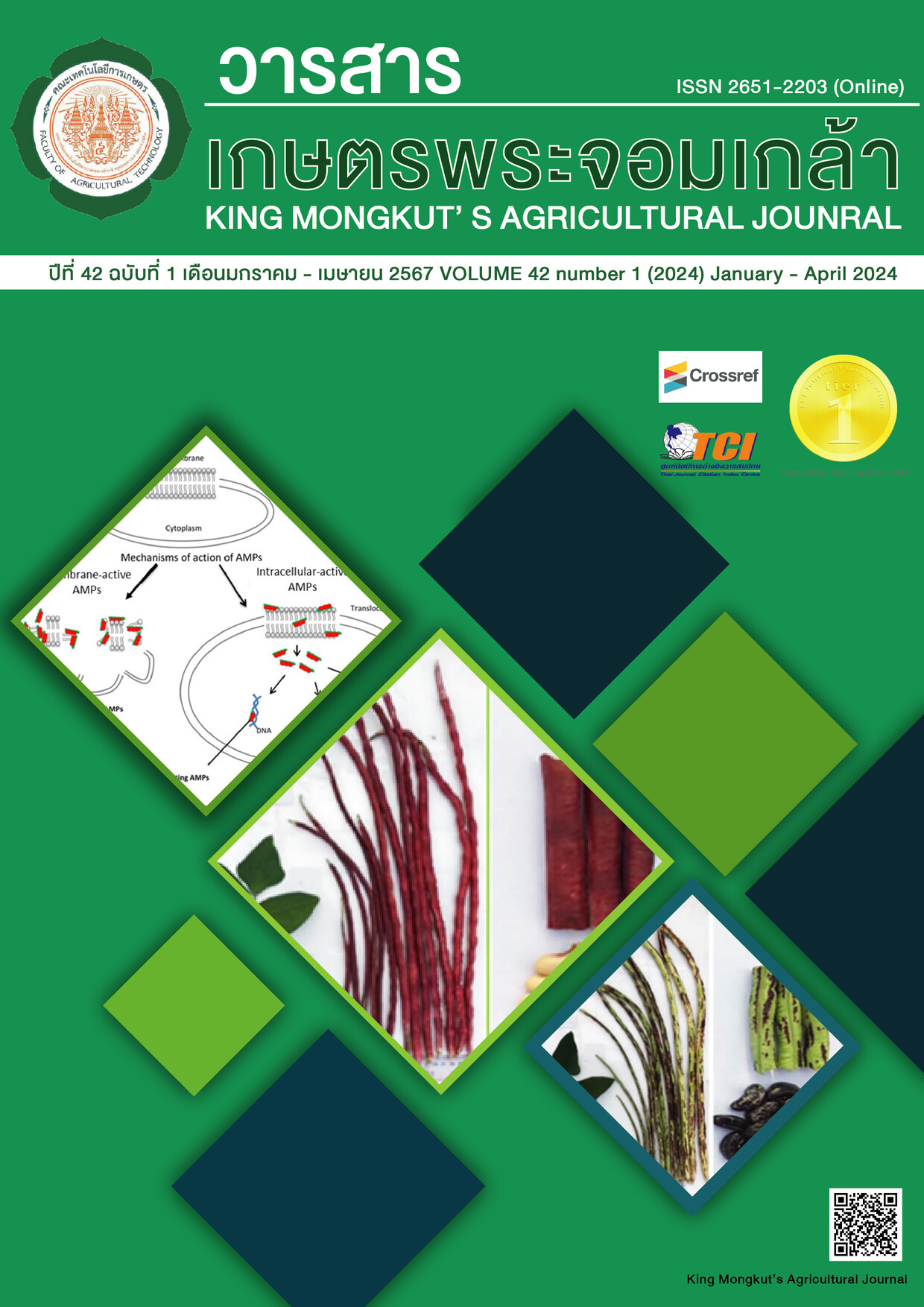อิทธิพลของไรโซเบียมร่วมกับเชื้อราอาร์บัสคูลาร์ไมคอร์ไรซาและแบคทีเรียย่อยฟอสเฟตต่อการเจริญเติบโตของถั่วลิสง พันธุ์ไทนาน 9
Main Article Content
บทคัดย่อ
การศึกษาการใช้เชื้อไรโซเบียมร่วมกับเชื้อราอาร์บัสคูลาร์ไมคอร์ไรซา และแบคทีเรียย่อยฟอสเฟตต่อการเจริญเติบโตของถั่วลิสงในกระถาง โดยวางแผนการทดลองแบบสุ่มสมบูรณ์ (Completely Randomized Design : CRD) ประกอบด้วย 5 กรรมวิธี จำนวน 4 ซ้ำ ได้แก่ กรรมวิธีที่ 1 ไม่ใส่เชื้อ(Control) กรรมวิธีที่ 2 ใส่เชื้อไรโซเบียม(R: Rhizobium sp.) กรรมวิธีที่ 3 ใส่เชื้อไรโซเบียมร่วมกับเชื้อราอาร์บัสคูลาร์ไมคอร์ไรซา(R+AM) กรรมวิธีที่ 4 ใส่เชื้อไรโซเบียมร่วมกับแบคทีเรียย่อยฟอสเฟต(R+PSB: Rhizobium sp. + Bacillus sp.) กรรมวิธีที่ 5 ใส่เชื้อไรโซเบียมร่วมกับเชื้อราอาร์บัสคูลาร์ไมคอร์ไรซาและแบคทีเรียย่อยฟอสเฟต(R+AM+PSB) พบว่าการใส่เชื้อไรโซเบียมร่วมกับเชื้อราอาร์บัสคูลาร์ไมคอร์ไรซาและแบคทีเรียย่อยฟอสเฟตส่งผลให้มีความยาวราก น้ำหนักสดและแห้งของส่วนเหนือดินและรากสูงที่สุด การใส่เชื้อไรโซเบียมร่วมกับเชื้อราอาร์บัสคูลาร์ไมคอร์ไรซาทำให้จำนวนปม (115 ปม/ต้น) น้ำหนักสดและน้ำหนักแห้งของปม (0.65 และ 0.16 กรัม/ต้น) สูงที่สุด การใส่เชื้อไรโซเบียมร่วมกับเชื้อราอาร์บัสคูลาร์ไมคอร์ไรซาและแบคทีเรียย่อยฟอสเฟตส่งผลให้เปอร์เซ็นต์การเข้ารากของเชื้อราอาร์บัสคูลาร์ไมคอร์ไรซาสูงที่สุด (26.64%) ปริมาณไนโตรเจนของส่วนเหนือดินสูงที่สุดเมื่อมีการใช้เชื้อไรโซเบียมร่วมกับแบคทีเรียย่อยฟอสเฟต ส่วนปริมาณฟอสฟอรัสและโพแทสเซียมของส่วนเหนือดินและรากไม่มีความแตกต่างในทางสถิติระหว่างกรรมวิธี การใช้เชื้อไรโซเบียมร่วมกับแบคทีเรียย่อยฟอสเฟตส่งผลให้ปริมาณการตรึงไนโตรเจนสูงที่สุดคือ 87.73 มิลิกรัมไนโตรเจน/ต้น
Article Details

อนุญาตภายใต้เงื่อนไข Creative Commons Attribution-NonCommercial-NoDerivatives 4.0 International License.
วารสารเกษตรพระจอมเกล้า
เอกสารอ้างอิง
Agricultural Research Development Agency. (2017). Maize, Soybean, Mungbean and Peanut, the Direction of Thai Economic Crops in ASEAN. 2nd ed. Pornsup Printing Co., Ltd. (in Thai).
Inthasan, J. (2020). Soil Fertility. 2nd ed. Design Print media. (in Thai).
Inthasan, J., Dechiraratthanasiri, C., & Boonmee, P. (2016). Effect of amendments combined with phosphate solubilizing bacteria on soil chemical properties under moringa canopy. Journal of Agriculture, 32(3), 379-390. (in Thai).
Atlas, R. M. 2005. Handbook of Media for Environmental Microbiology. 2nd ed. CRC Press.
Anzuay, M. S., Ludueña, L. Angelini, J., & Fabra, A. (2015). Beneficial effects of native phosphate solubilizing bacteria on peanut (Arachis hypogaea L.) growth and phosphorus acquisition. Symbiosis, 66, 89–97.
Badawi, F. Sh. F., Biomy, A. M. M., & Desoky, A. H. (2011). Peanut plant growth and yield as influenced by co-inoculation with Bradyrhizobium and some rhizo-microorganisms under sandy loam soil conditions. Annals of Agricultural Science, 56, 17-25.
Bai, Y., Zhou, X., & Smith, D. L. (2003). Enhanced soybean plant growth resulting from coinoculation of Bacillus strains with Bradyrhizobium japonicum. Crop Ecology, Management & Quality: Crop Science, 43(5), 1774–1781.
Beck, D. P., Materon, L. A., & Afandi, F. (1994). Practical Rhizobium-legume technology manual: Technical manual No. 19. International Center for Agricultural Research in the Dry Areas (ICARDA).
Brundrett, M., Bougher, N., Dell, B., Grove, T., & Malajczuk, N. (1996). Working with Mycorrhizas in Forestry and Agriculture. Pirie Printers.
Cui, L., Guo, F., Zhang, J. L., & Yang, S. (2019). Arbuscular mycorrhizal fungi combined with exogenous calcium improve the growth of peanut (Arachis hypogaea L.) seedlings under continuous cropping. Journal of Integrative Agriculture, 18(2), 407-416.
FAO. (2008). FAO Fertilizer and Plant Nutrition Bulletin. FAO.
Jackson, M. L. (1958). Soil Chemical Analysis. Prentice Hall, Inc.
Kumar, N., Kumar, A. Shukla, A., & Ram, A. (2018). Effect of application of bio-inoculants on growth and yield of Arachis hypogaea L. and Sesamum indicum L. International Journal of Current Microbiology and Applied Sciences, 7(1), 2869-2875.
Lekberg, Y., & Koide, R. T. (2005). Arbuscular mycorrhizal fungi, rhizobia, available soil P and nodulation of groundnut (Arachis hypogaea) in Zimbabwe. Agriculture, Ecosystems and Environment, 110, 143–148.
Marschner, H., & Dell, B. (1994). Nutrient uptake in mycorrhizal symbiosis. Plant Soil, 159, 89-102.
Massoud, O. N., & El-Batanony, N. H. (2009). Fertilizers management and N2-fixers combined with phosphate solubilizing microorganisms affect peanut (Arachis hypogaea) growth and productivity. New Egyptian Journal of Microbiology, 22, 1-15.
Peoples, M. B., Faizah, A. W., Rerkasem, B., & Herridge, D. F. (1989). Methods for Evaluating Nitrogen Fixation by Nodulated Legumes in the Field. Pirie Printers.
Peoples, M. B., Bell, M. J., & Bushby, H. V. A. (1992). Effect of rotation and inoculation with Bradyrhizobium on nitrogen fixation and yield of peanut (Arachis hypogaea L., cv. Virginia Bunch). Australian Journal of Agricultural Research, 43, 595–607.
Poomipan, P., Suwanarit, A., Suwanarit, P., Nopamornbodi, O., & Dell, B. (2011). Reintroduction of a native Glomus to a tropical Ultisol promoted grain yield in maize after fallow restored the density of arbuscular mycorrhizal fungal spores. Journal of Plant Nutrition and Soil Science, 174, 257-268.
Toomsan, B., McDonagh, J. F., Limpinuntana, V., & Giller, K. E. (1995). Nitrogen fixation by groundnut and soya bean and residual nitrogen benefits to rice in farmers’ fields in Northeast Thailand. Plant Soil, 175, 45–56.
Vincent, J. M. (1970). A Manual for the Practical Study of the Root Nodule Bacteria. IBP, Handbook, No. 15. Blackwell Publishers.


